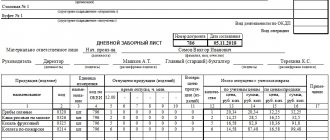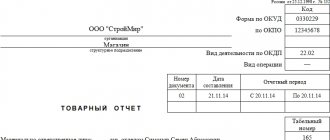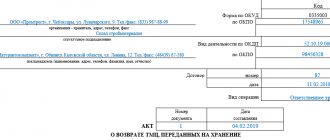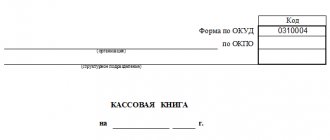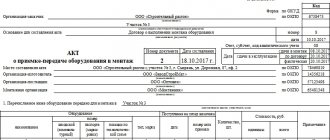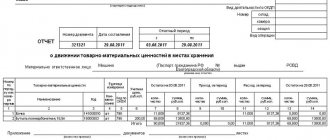The act form KS-17 is a document designed to confirm the existence of the fact of suspension (sometimes conservation) of construction work on a specific object on a specific site. In the article we will talk about KS-17 Construction Suspension Act and provide answers to frequently asked questions.
The form substantiates the basis that allows for mutual settlements between the parties to the agreement, since the contractor has received confirmation of the customer’s decision regarding the suspension or complete cessation of construction. The form was approved by the State Statistics Committee on November 11, 1999 by issuing its Resolution No. 100.
What is the KS-17 act used for?
With the help of an act of suspension of construction, the representative of the customer and the contractor express their mutual intention to temporarily stop the construction work being carried out at a specific site. The act is certified by the signatures of both parties and explains the reasons for the suspension, as well as cost indicators regarding the planned expenses for construction work and the work actually performed at the time of suspension.
After preparing the act under consideration, participants in the suspended construction process should begin implementing the next stage, which involves determining the full range of works associated with the implementation of measures aimed at preserving the facility.
Particular attention is paid to determining the cost component, interconnected with the processes after the suspension of work (organization of security measures at a “frozen” facility, purchase of material assets, etc.) Preparation of the KS-17 act may imply both the process of terminating relations and their temporary termination.
If an investor appears in the relationship, then he may be asked to provide a financial resource specified by the investment contract.
In accordance with legislative provisions, the conservation process does not imply the termination of contractual relations in the field of construction of the facility, therefore, the parties are recommended to provide in advance in the contract the procedure for action in the event of a suspension of the construction process.
Notice of suspension of work
0 Having concluded a contract, one party (contractor) undertakes to perform certain work on the instructions of the other party (customer) and deliver the result to the customer, and the customer undertakes to accept the result of the work and pay for it ().
The document may also be needed at the stage of re-opening a construction site.
Certain types of contracting agreements include household contracting, construction contracting, contracting for design and survey work, contracting work for government needs. Despite the fact that the deadlines for completing work under a work contract are essential terms of such an agreement, this does not mean that they cannot change.
The initial, final and intermediate (if established) deadlines for the completion of work can be changed in cases and in the manner provided for by the contract ().
A change in the deadlines for completing work may be caused, among other things, by the suspension of work by the contractor. We will tell you when such a suspension is possible, as well as whether it is necessary to draw up a notice to the customer about the suspension of work. In accordance with this, the contractor has the right not to start work, but to suspend the work begun if:
- or there are circumstances clearly indicating that the customer will not fulfill his obligations within the prescribed period ().
- or the customer violated his obligations under the contract (for example, did not provide technical documentation or things to be processed);
Unless otherwise provided by the contract, in the presence of the above circumstances, the contractor has the right to refuse to perform the contract and demand compensation for losses ().
The provisions do not oblige the contractor to notify the customer of the suspension, however, judicial practice, also based on the provisions of paragraph 1 of Art. 716 of the Civil Code of the Russian Federation, says that the contractor must still notify the customer about the suspension of work (, ,). Naturally, the terms of the concluded agreement must also be taken into account.
If the obligation to notify about the suspension of work is provided for in such contracts, the contractor is all the more obliged to fulfill it.
We recommend reading: What is the maximum duration of overtime work, indicate 2 options
Who fills out the KS-17 act form
The form is drawn up by the customer who initiated the construction project when he or the investor party initiates a decision related to the termination of construction work. Drawing up an act requires preparing as many copies as the given situation requires. There are at least two of them – for the customer and the contractor; It is possible to provide the document to the investor (upon request).
The form must be kept in the accounting departments of the parties to the contract. To correctly fill out the provisions of the act on suspension of construction, the presence of data obtained on the basis of information from primary sources (forms KS-6, KS-6a) is required.
Suspension of work under a contract
Thus, taking into account all of the above, we do not exclude the possibility that in the case under consideration, failure by the customer to pay for the next stage of work performed may be grounds for the contractor to suspend the work at subsequent stages and for abandoning the contract as a whole, if such failure to pay is objectively capable of preventing the execution subsequent stages of work by the contractor.
Filling out the act The customer fills out the act. To accurately enter data, it may be necessary to refer to other documents: forms KS-6 and KS-6a. The form must be filled out on both sides. Front side This is where the introductory part and the table are located.
Indeed, situations arise very often. when work has been stopped for a long time, is not being carried out, but the Customer is not officially informed about this, this has not been agreed upon with him.
The procedure for sending a notice of suspension of work Having identified the presence of these factors, the contractor is obliged to stop any activity at the site and send the customer a notice of suspension of work under the contract with a request to clarify its further steps.
Indeed, situations arise very often. when work has been stopped for a long time, is not being carried out, but the Customer is not officially informed about this, this has not been agreed upon with him.
A separate line represents the name of the document itself, next to which its number and date of preparation are located.
Who signs the document form?
In most cases, the following persons participate in signing the act of suspension of construction work:
- head of the customer organization;
- head of the contractor company;
- chief accountants of these parties.
Sometimes authorized representatives of these parties can take part in the signing of the KS-17 act if there are powers of attorney issued for them accordingly. Signatures are recorded on the back of the form, where they are stamped.
Is it necessary to use this particular form?
The act of suspension of construction, or rather, its form, is included in the album of unified forms that were approved by the Post. Goskomstat of Russia November 11, 1999 No. 100.
Since 2013, all mandatory forms have become only recommended for use. Each organization has the right to develop its own forms that are convenient for it. You can enter the necessary columns and rows into the tables, adjust other parts of the form, but you just need to approve the new form in the organization’s accounting policy. A special order is issued for this purpose.
For your information! In fact, many companies use the KS-18 form, since it is convenient and fully reflects all data related to the suspension of construction.
How is an act of form KS-17 drawn up?
The structure of the document contains the following components:
- A general purpose section, implying a list of data about the parties to the transaction (the title part of the KS-17 form);
- Front sheet tables;
- Similar tabular form from the back page;
- Final aspects and signatures of the parties.
The upper part of the front side of the KS-17 act form contains the information:
- full name of the investor organization indicating contact details, location address and registration details according to OKPO;
- similar information relating to the contractor and the customer company, separated by separate lines;
- the name of the construction project scheduled for suspension with the designation of its location address;
- data on the work contract indicating its essential details - date and number;
- a document that serves as the basis for performing construction work on a specific site;
- the basis (in the form of the title of the document), the action of which provoked the cessation of the work process at the construction site.
A separate line represents the name of the document itself, next to which its number and date of preparation are located.
The following is a tabular section containing data characterizing the construction project proposed for suspension. The table includes 12 columns to be filled out. Filling out the columns of the tabular part of the KS-17 form:
| Column number | Explanations for filling |
| 1 | Sequential numbering of table records. |
| 2 | Assignment with the name of the construction project, as well as the list of works and incurred costs caused by the process of stopping construction. |
| 3 | Object code, if assigned. |
| 4 | The date indicating the start of construction work. |
| 5, 6 | A monetary value that determines the total cost of work on site (both general and work related to construction and installation, which are divided into separate columns in the table). |
| 7, 8 | The contract (estimated) cost of the completed list of works performed at the time the construction process was stopped (there is also differentiation here by the full amount and due to construction and installation operations). |
| 9 | Actual costs according to the balance sheet information of the developer, incurred as of the date indicating the fact of termination of construction work. |
| 10 | The required amount of funds for mutual settlements with the contractor, including the share of work in progress. |
| 11 | A fixed component of the amount of money indicated in the previous column in terms of reimbursement to the contractor for expenses incurred upon termination of the contract related to unsold materials and structures. |
| 12 | The required cost of expenses allocated, if necessary, to perform work related to the conservation of the specified object. |
Purpose of the act
So, the act is necessary to consolidate the mutual consent of the customer and the contractor to suspend work on the construction of any facility. The act specifies the reasons why construction is being mothballed or stopped, and indicates the amounts required for mothballing and other further actions.
The document may also be needed at the stage of re-opening a construction site. In order to begin work, it may be necessary to compare the characteristics of the building at the time of conservation with the current parameters. During the time that the object was “waiting” for re-preservation, its condition could change: some parts have become unusable or are in poor condition and need to be replaced.
Accountant's Directory
04/10/2020 Contents Act on suspension of construction. Form KS-17 is a document confirming the fact of suspension of work at a construction site (their conservation or complete cessation).
The act is the basis for settlement between the customer and the contractor after the contractor has received confirmation of the decision to suspend construction. The form of the form was approved by the Decree of the State Statistics Committee of the Russian Federation dated November 11, 1999.
No. 100. OKUD form code 0322010. The structure of the form consists of a part containing general data about the parties to contractual obligations, a table on the front and back of the form, as well as final details.
The tabular data on the back side of the document fully corresponds to the data on the front side and, in addition, contains information about the cost of the construction project, displayed in a separate line. In general, the act contains the following information: full name and contact information of the customer, contractor and investor;
Act of downtime due to the fault of the customer
6758 When carrying out various types of work, downtime often occurs. If this happened due to the fault of the customer, it is necessary to draw up a corresponding act.
FILES The concept of downtime includes the suspension of work for any period of time.
Downtime can be either planned (with the aim, for example, of maintaining production and optimizing costs) and then it is controlled and lasts for a strictly defined period, or unplanned and unforeseen (due, for example, to the failure of one of the parties to fulfill its obligations) - in this case The duration of the downtime cannot be determined. A variety of circumstances can lead to downtime.
In particular, there are often cases when this happens due to a lack of materials for the work or the absence of workers in their place. Downtime can also occur due to equipment breakdowns, equipment malfunctions, decreased demand for products manufactured by the enterprise, or any financial difficulties.
Conservation of an unfinished construction site
1.1.
In accordance with the Rules (), conservation means bringing an object and the territory used for its construction (construction site) into a state that ensures the strength, stability and safety of structures, equipment and materials, as well as the safety of the object and construction site for the population and the environment .
1.2. According to the developer (or customer) must ensure conservation of the capital construction project if it is necessary to stop work or temporarily suspend it for a period of more than six months.
1.3. Conservation procedure 1.3.1. In case of termination or suspension of construction work for more than six months, the developer (customer) makes a decision on the conservation of the object (with the exception of a state-owned property) and on the source of funds to pay the costs associated with the conservation. 1.3.2. Such a decision must determine:



